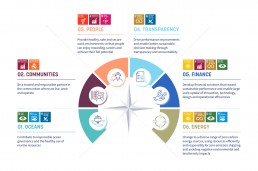This piece originally appeared in Nordea’s Open Insights blog prior to the Nordea Sustainable Finance and Shipping Forum. Watch the event recording here.
Shipping is one of the lowest emission-intensive modes of transporting goods, compared to, for example, trucking or aviation. However, accounting for around 80% of world trade, the shipping industry is also among the largest carbon emitters, with over one billion tons of greenhouse gas emissions each year, similar to the total carbon emissions of Germany. Such emissions are expected to grow by 50-250% by 2050 if left unchecked.
While the industry has largely been out of sight and out of mind, that’s changing, according to Andrew Stephens, Executive Director at the Sustainable Shipping Initiative (SSI). Demand-side stakeholders, including civil society, lenders, investors and cargo holders, are exerting more pressure on the industry to reduce its environmental impact and improve its sustainability performance.
What are the biggest challenges in the shipping sector when it comes to becoming more sustainable?
Transparency. More is happening in the way the industry operates, for example through decarbonisation, where emission targets, regulatory requirements and demand from financial stakeholders and customers are paving the way to more disclosure and transparency. But how is reporting done, and how credible is it? Is it voluntary, and is it verified by any external authorities, bodies or agents?
Historically, shipping has been resistant to sharing information for fear of it being used in a competitive way, even if not proprietary. Transparency thus remains a challenge, but it is trending upwards, with more demand for data enabling stakeholders to make informed decisions around sustainability performance.
Financial institutions are leading the way forward with, for example, the Poseidon Principles, through which they disclose data on the climate alignment of their shipping portfolios.
Where is the most progress being made?
Right now, progress is focused on the decarbonisation front. That’s where we see real discourse, action and collaboration between public and private sectors. There’s a hunger for rapid decarbonisation and a need for stakeholders to work together on this problem – it will not be fixed by one group alone.
The discussion at the moment is focused on alternative fuels and technologies for decarbonisation, which SSI is working on as a knowledge partner of the Fuels & Technologies workstream of the Getting to Zero Coalition. Additionally, the sustainability credentials of these fuels are also a key issue under consideration, ensuring that, for example, hydrogen and ammonia are derived from sustainable sources. The breakthroughs are there from a technical perspective, but it’s the scaling up and the upstream infrastructure that need addressing.
This presents an opportunity for finance to enable and support shipping’s transition to zero (or low) carbon fuels such as green hydrogen or green ammonia from wind and solar.
What role do you see sustainable finance playing in the transition?
Financial market actors are among the key stakeholders and levers for driving progress in the industry. They have a significant influence across the shipping value chain in terms of being able to demand action.
The levers are both carrot and stick. Some banks have taken the stick approach of removing poor performers or sectors not in line with certain policies or positions. The alternative approach is to partner with the elements of an industry to not just agree on incentives, which could be preferential loans or rates based on good performance, but to also play a key role in sharing and inspiring how it can be done.
The Climate Bonds Initiative has launched criteria to steer investments in the shipping industry, rewarding those not carrying fossil fuels and those operating zero-emission vessels or targeting to become zero-emission. And it’s not just about ship owners. Charterers are also helping to drive the requirements for low-carbon initiatives through the supply chain, having those requirements put into their contracts and reporting on that. The more these initiatives are shared across the value chain and incentive-driven, the more they will be taken up.
Making the shipping industry more sustainable is a collective challenge, requiring engagement from all actors across the value chain – whether it’s decarbonisation, responsible ship recycling, or safeguarding labour and human rights for seafarers and other shipping workers. Finance has the power to provide guidance and support, sharing its knowledge of what is possible and partnering with the industry to bring about positive change.

